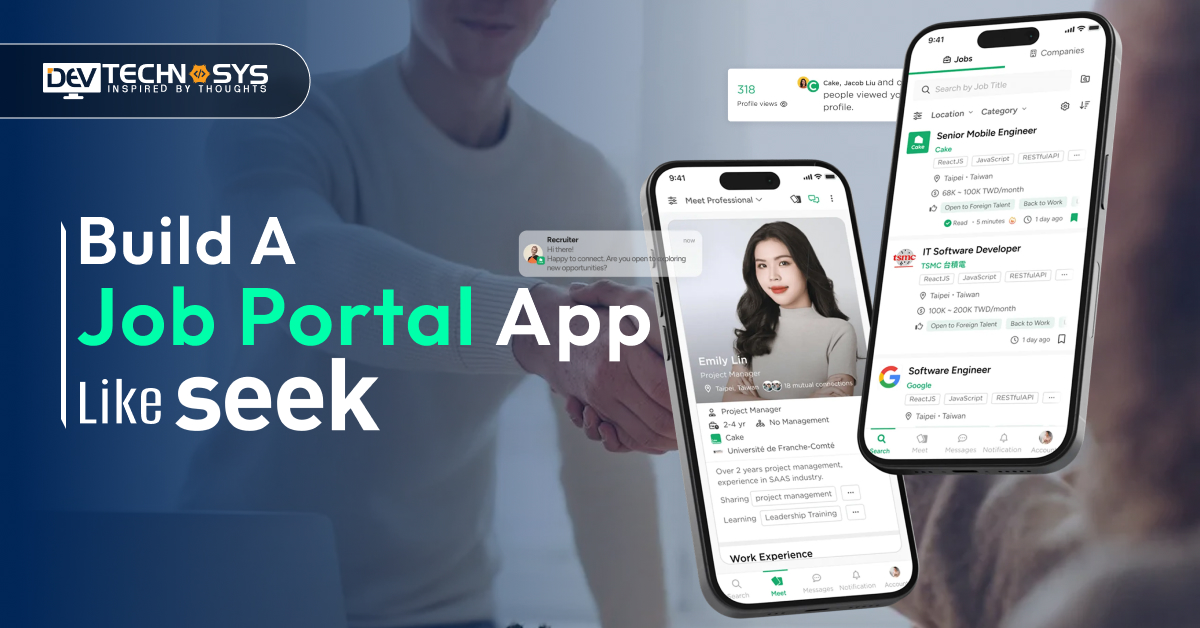“Careers Start Here”
Finding a job is one of the toughest tasks. Do you remember the time when people went from office to office to apply for a job? But now everything is changed. Many popular job portal platforms help job seekers find their perfectly matched job, and job seekers can also apply as per their requirements.
A job portal app like Seek is a leading job portal platform in Australia, where job seekers can easily find a job according to their expertise and skills.
The job portal app industry is on the rise, expected to grow from $504.52M to $875.98M by 2031.
The above data depicts that investing in the job portal app development is a huge opportunity
For entrepreneurs who want to start a job board application.
In this blog, we will explore how to build a job portal app like Seek and how it can be beneficial for today’s businesses.
Explore More!
What is Seek?
Seek is a leading job portal based in Australia, connecting job seekers with employers across various industries. Launched in 1997, it offers job listings, resume-building tools, company insights, and career advice. Job portal apps like Indeed or Seek also provides recruitment solutions for businesses, making it a trusted platform for employment opportunities in Australia, New Zealand, and several international markets.
- Advanced Job Search
- Profile & Resume Builder
- Job Alerts
- Salary Insights
Market Analysis of Global Job Portal Applications
- The ground-level analysis estimated the market for employment portal apps to be worth around $504.52 million in 2024. By the end of 2031, it is anticipated to have increased to around $875.98
- In a deep research, the job portal applications market is expected to grow with a compound annual growth rate of14% from 2025 to 2031.
- The rising need for competent personnel, as well as the necessity to present crucial information to applicants on the career page, are expected to drive the Job Board Software.
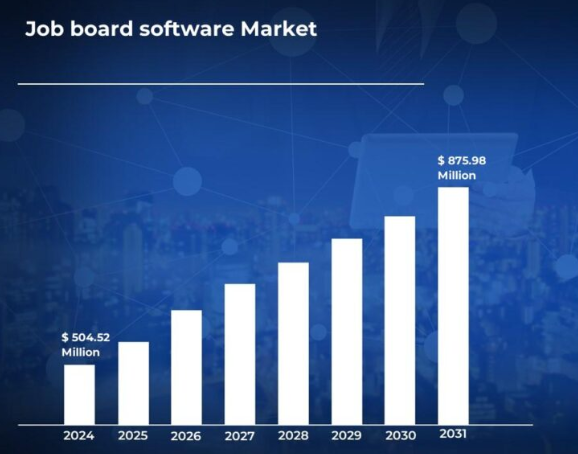
- The biggest players include Niceboard, Jobboard, Smart Jobbboard, Astoundify, RussMedia Solutions, Jobbex, HiringOpps, JazzHR, Madgex, and LinkedIn Jobs.
- The global job board software market is divided into three segments: type, application, and geography.
10 Trending Job Portal Apps Like Seek
Here are 10 best job portals like Seek! They help job seekers to find good jobs fast. These apps are easy to use and have many job choices for everyone. Try them and find your dream job!
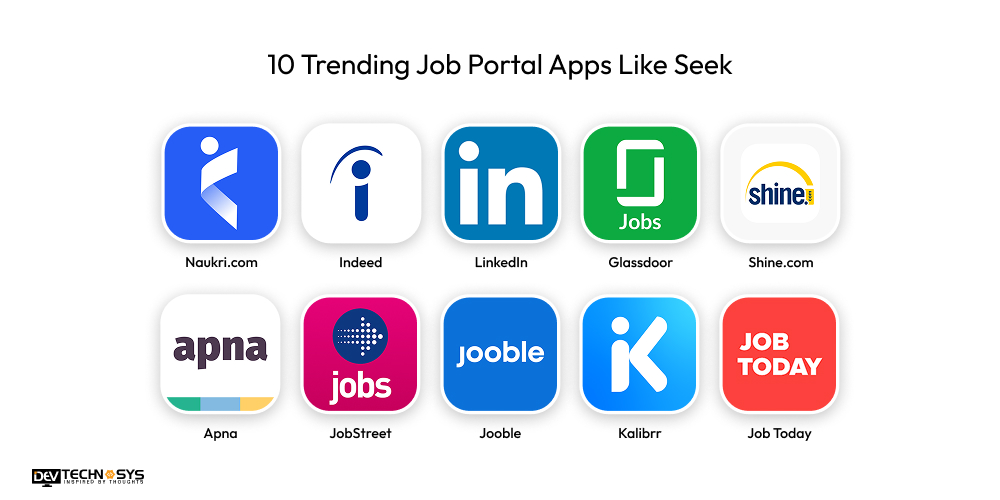
Applications |
Download Users |
Stores Ratings |
Apps Launched On |
Platform Accessibility |
| Naukri.com | 100M+ | 4.5 | 2012 | Android/iOS |
| Indeed | 100M+ | 4.5 | 2004 | Android/iOS |
| 1B+ | 4.6 | 2003 | Android/iOS | |
| Glassdoor | 10M+ | 4.3 | 2008 | Android/iOS |
| Shine.com | 10M+ | 3.9 | 2008 | Android/iOS |
| Apna | 10M+ | 4.4 | 2019 | Android/iOS |
| JobStreet | 10M+ | 4.4 | 1997 | Android/iOS |
| Jooble | 10M+ | 4.5 | 2006 | Android/iOS |
| Kalibrr | 1M+ | 4.2 | 2012 | Android/iOS |
| Job Today | 5M+ | 4.3 | 2015 | Android/iOS |
Why Entrepreneurs Want to Invest in Job Portal App Development?
Job portal applications are becoming vital resources for both companies and job seekers in the fast-paced digital world of today. The creation of employment portal apps is becoming more and more popular among entrepreneurs as a wise business decision. So, here we provide the online job portal working and benefits:

1. Increased need for Online Recruitment
As more professionals look for opportunities online, the need for digital job portals is increasing. Companies embrace online recruiting because of its quickness and accessibility. Entrepreneurs notice this trend and want to capitalize on a rising user base that comprises both job seekers and recruiters.
2. Recurring Revenue Opportunities
If you develop a job portal app like Dice, it can generate income through a variety of channels, including premium job posts, prominent employer listings, resume database access, and subscription programs. These recurring revenue models make employment portal apps extremely successful in the long run, appealing to both investors and creators.
3. Scalable Business Model
An employment portal app might start modest and expand rapidly. As the user base grows, so do the opportunity to enter new sectors, regions, or specialty markets (such as tech employment, gig labor, or internships). This scalability is a major reason why entrepreneurs consider it a low-risk, high-reward venture.
4. Data-Driven Insights with AI Integration
To create a job portal website, it can collect useful information regarding user behavior, industry demand, and hiring trends. Entrepreneurs are keen to exploit this data to improve matching algorithms, roll out AI-powered job suggestions, and customize user experiences. These enhancements make the platform more engaging and functional.
5. Contribution to Employment and Economic Growth
Aside from profit, many entrepreneurs are driven by the opportunity to make a significant difference. Job portals link people to possibilities, promote career development, and minimize unemployment. This social benefit, paired with a large market potential, makes employment portal creation a rewarding endeavor.
How AI Can Improve the Operations of Job Portal Apps?
- AI analyzes user profiles to match candidates with the most relevant jobs, improving hiring accuracy and user satisfaction.
- It automates resume screening by quickly filtering out unqualified candidates, saving recruiters valuable time during the hiring process.
- It predicts job market trends by analyzing data, helping employers and job seekers make informed decisions about hiring and career moves.
- AI personalizes job recommendations based on user behavior, preferences, and past applications, increasing the chances of successful matches.
- AI detects fraudulent profiles and fake job listings to maintain the platform’s trustworthiness and protect users from scams.
7 Easy Steps to Build a Job Portal App Like Seek
Do you want to create a job portal app similar to SEEK? Create a strong, user-friendly platform that links employers and job seekers, increases recruiting efficiency, and aids in the establishment of a profitable recruitment technology company by following these seven simple steps. So, here is the robust job portal app development process:
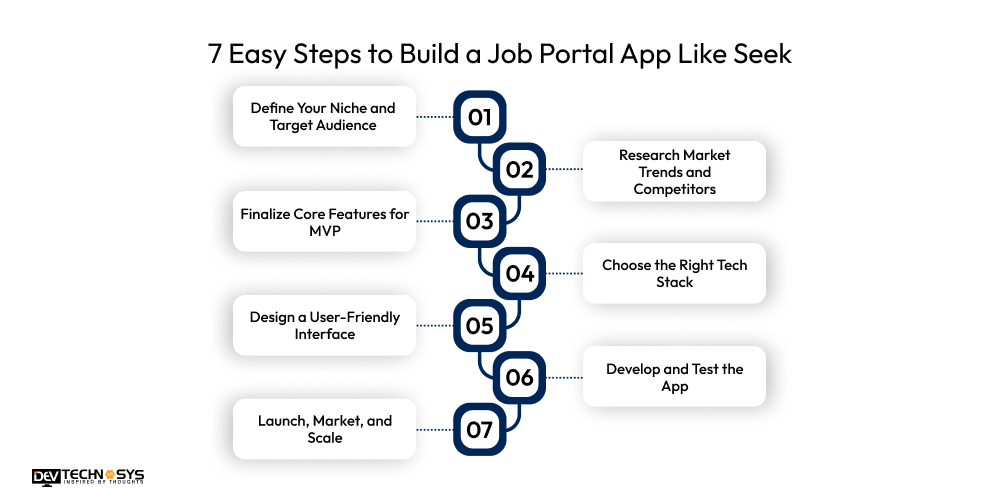
1. Define Your Niche and Target Audience
Start by identifying your niche—general jobs, remote work, tech-specific, etc. Understand your target users: job seekers, employers, or both. Hire mobile app developers to understand their needs will shape your app’s features, design, and marketing strategy to achieve maximum relevance and engagement.
| Who is my ideal user: job seeker, recruiter, or both? |
| What type of jobs will the platform focus on (e.g., tech, remote, freelance)? |
| Is the app targeting a specific industry or all job sectors? |
2. Research Market Trends and Competitors
Come to the second stage to develop an app like Seek, analyze job portal giants like SEEK, LinkedIn, and Indeed. Study their strengths, weaknesses, and user feedback. Look for gaps in the market you can fill with better features, localized services, or a more intuitive user experience to stand out.
| Who are the top competitors in this space? |
| What features do popular job portals offer? |
| What do users like or dislike about existing job apps? |
3. Finalize Core Features for MVP
Hire dedicated developers to plan the must-have features for your Minimum Viable Product (MVP). These include user registration, job search filters, resume upload, job posting, alerts, and chat options. Focus on essential functions to launch quickly, gather feedback, and improve continuously.
| What features are essential for job seekers? |
| What tools do employers need to post jobs and manage applicants? |
| Should users be able to upload or build resumes in the app? |
4. Choose the Right Tech Stack
Let’s move to the fourth stage to build an app like Seek, select reliable technologies for your backend, frontend, and database. Common choices include React Native or Flutter for mobile apps, Node.js or Django for backend, and PostgreSQL or MongoDB for data. Make sure your tech stack supports scalability and security.
| Will the app be available on web, Android, and iOS? |
| Should I use native or cross-platform development? |
| What backend language and framework best suit my needs? |
5. Design a User-Friendly Interface
In the fifth job portal mobile app development process, create clean, simple, and intuitive UI/UX designs. Use wireframes and prototypes to map out user journeys. Ensure your design allows users to navigate job listings, apply easily, and manage profiles without confusion. Mobile responsiveness and fast loading are key.
| Is the app easy to navigate for all users? |
| Are buttons and icons clear and accessible? |
| Does the layout guide users naturally through the process? |
6. Develop and Test the App
In the sixth stage, to create an app like Seek, begin development in stages: frontend, backend, API integration, and database. Regularly test for bugs, security issues, and performance problems. Use both automated and manual testing. A bug-free experience builds user trust and encourages continued usage and referrals.
| Are there any bugs or crashes during common tasks? |
| Is user data protected with proper security measures? |
| Is the loading time fast enough for a good user experience? |
7. Launch, Market, and Scale
Consult with top job portal development companies to launch your app on Android, iOS, and web platforms. Promote it using SEO, social media, and partnerships with recruiters. Collect user feedback, release updates, and scale features gradually. Stay responsive to market needs to grow sustainably over time.
| Is the app ready for launch on all planned platforms? |
| Which channels will I use for promotion (social, SEO, ads)? |
| Do I have a content or blog strategy in place? |
10 Must-Have Advanced Features of Job Portal Apps Like Seek
To stand out and offer great value, job portal apps like Seek need advanced features beyond basic job listings. Here are 10 essential ones:
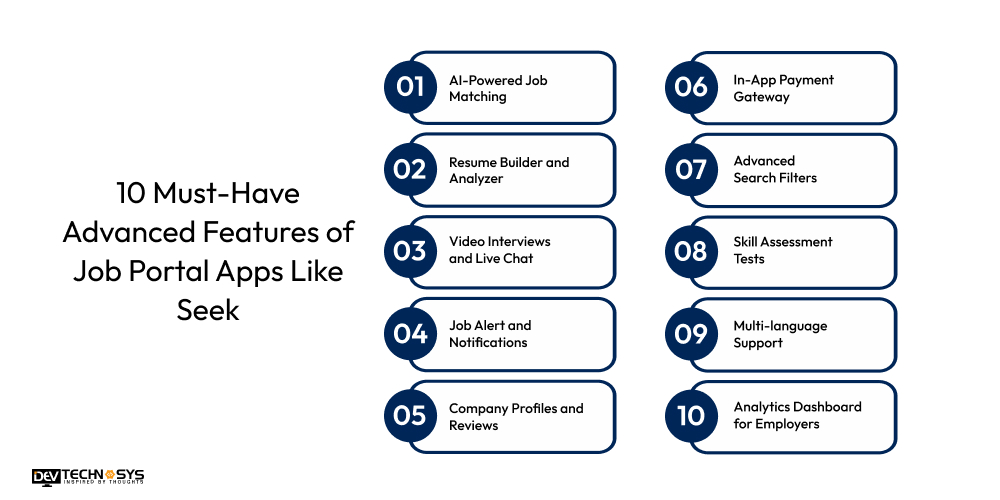
1. AI-Powered Job Matching
Seek alternatives use artificial intelligence to assess job seekers’ abilities and interests, then automatically match them to the most suited positions, reducing time and increasing success rates.
2. Resume Builder and Analyzer
LinkedIn alternatives allow users to create resumes within the app and receive AI input to improve their CVs for greater chances with recruiters.
3. Video Interviews and Live Chat
The Seek clone apps allow companies to interview candidates directly on the app, which will speed up the recruiting process.
4. Job Alert and Notifications
Send out individualized job alerts based on search history and saved preferences to keep users interested and informed.
5. Company Profiles and Reviews
The Seek clone apps provide complete firm profiles, including employee evaluations and ratings, to assist prospects in making educated judgments.
6. In-App Payment Gateway
The similar app like Seek allow employers to pay for premium listings or highlighted advertisements from within the app for a more streamlined experience.
7. Advanced Search Filters
Include filters for location, pay, job kind, experience level, and other criteria to assist consumers in locating the ideal job quickly.
8. Skill Assessment Tests
Skilled staffing solutions offer online examinations to assess candidates’ abilities and provide companies with verified findings.
9. Multi-language Support
The Seek mobile app supports several languages to reach a more diversified user base, and it can enhance the user experience.
10. Analytics Dashboard for Employers
Seek alternatives provide companies with extensive data regarding job post performance, applicant demographics, and hiring patterns to help them optimize their recruiting.
The Cost to Build Job Portal App Like Seek
The cost to develop a job portal app like Seek varies widely based on features, platform, and location of developers. A basic version with essential features can cost around $8,000 to $16,000. Adding advanced features like AI matching, one way video interviews, and in-app payments can raise the price to $25,000 or more.
Development time usually ranges from 4 to 6 months. Ongoing expenses like maintenance, marketing, and updates should also be considered for long-term success. Choosing experienced developers and clear planning helps optimize the overall job portal development cost.
Job Portal App Development |
Estimated Cost |
Time Frame |
Basic App Development |
$8000 – $12000 | 2 to 4 Months |
Mid-Premium App Development |
$14000 – $19000 | 5 to 8 Months |
High-Premium App Development |
$25000+ | 9+ Months |
5 Major Factors That Affect the Job Portal App Development Cost
Wondering what drives the cost of building a job portal app? Key factors include app complexity, feature set, platform choice (iOS, Android, or both), design quality, developer location, backend infrastructure, and post-launch support. Each of these elements can significantly impact your overall job search app development budget and timeline.
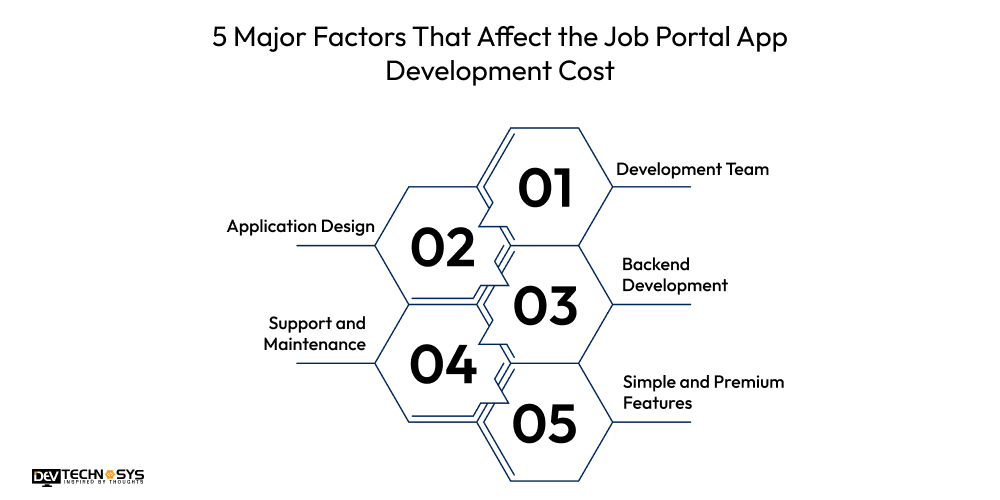
1. Development Team
The number, expertise quality, and location of your development team have a significant impact on the overall online job portal app development cost. Hiring developers in North America or Europe costs more than in Asia. Rates vary across freelancers, in-house teams, and outsourced firms. More experienced teams may cost more, but they provide outcomes faster and with greater quality.
Developers Experience level |
United States |
United Kingdom |
Southeast Asia |
Eastern Europe |
| Junior-level | $15 – $25 | £14 – £24 | $12 – $22 | $10 – $20 |
| Mid-level | $30 – $50 | £27 – £44 | $25 – $35 | $25 – $33 |
| Senior-level | $60 – $80 | £50 – £65 | $40 – $55 | $40 – $50 |
2. Application Design
A well-designed software enhances the user experience while increasing the mobile app development cost. Custom UI/UX designs, animations, and responsive layouts demand additional design time. Investing in efficient navigation and a visually appealing interface helps retain users and improves brand image, but it increases the initial Seek app development cost.
Design Quality |
Cost Estimation |
| Basic Design | $8,000 – $12,000 |
| Complex Design | $15,000 – $22,000 |
3. Backend Development
Your employment portal’s backend is its essential engine. It handles databases, user accounts, job ads, communications, and other functions. A safe, scalable, and resilient backend necessitates extra Seek app development cost particularly when integrating third-party services or creating complicated data processing systems such as job matching or analytics.
Backend Complexity |
Estimated Cost (USD) |
Estimated Time |
| Basic Backend | $5,000 – $10,000 | 3 – 6 weeks |
| Advanced Backend | $10,000 – $18,000 | 6 – 10 weeks |
4. Support and Maintenance
Following the initial launch, ongoing maintenance is required for bug repairs, upgrades, and performance enhancements. Regular maintenance ensures that your software operates efficiently, is safe, and can adapt to new operating system changes or user demands. These post-launch services are recurrent fees that greatly increase the app’s overall lifetime cost to build a recruitment app.
Service Level |
Description |
Estimated Annual Cost (USD) |
Estimated Time |
| Basic Support | Bug fixes, minor updates | $3,000 – $6,000 | Ongoing |
| Comprehensive Support | Frequent updates, performance optimization | $6,000 – $9,000 | Ongoing |
5. Simple and Premium Features
Basic functions such as login, job search, and resume submission are needed and reasonably priced. Advanced features like AI job matching, video interviews, and in-app purchases add considerably to development time and expense. The more personalized and engaging the features, the more the investment required for optimal functioning.
Basic Features |
Estimated Cost |
Advanced Features |
Estimated Cost |
| Job Search | $6,000 – $9,000 | AI-Based Job Matching | $4,000 – $7,000 |
| Job Categories | $4,000 – $7,000 | Video Interview Integration | $3,000 – $5,000 |
| Job Posting | $8,000 – $12,000 | In-App Chat/Messaging | $10,000 – $14,000 |
| Bookmark Jobs | $7,000 – $11,000 | Resume Builder Tool | $7,000 – $10,000 |
| Contact Form or Support Chat | $10,000 – $12,000 | Advanced Search Filters | $10,000 – $15,000 |
How to Make Money From Job Portal Apps Like Seek?
Job portal app like Naukri.com or Seek are not just valuable for connecting job seekers and employers—they also offer strong earning potential. Here are five proven monetization strategies to generate revenue from your job portal app:
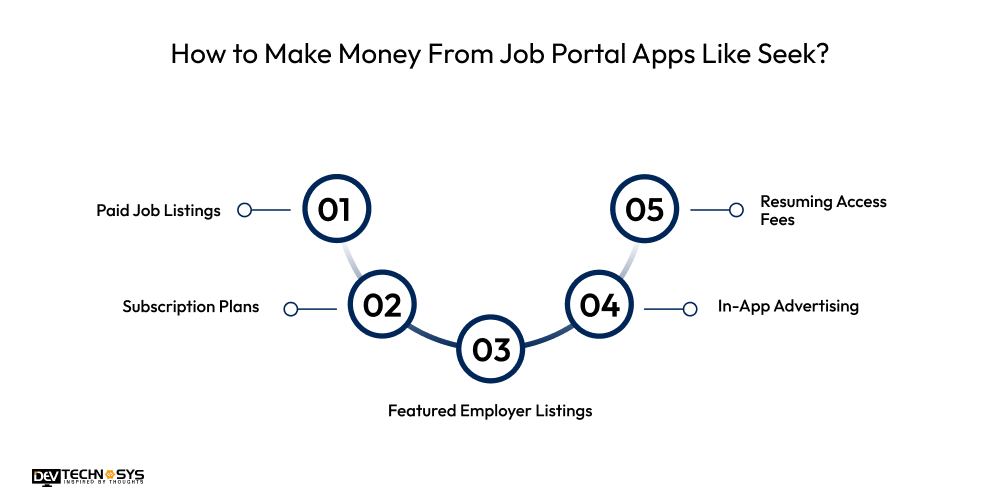
1. Paid Job Listings
One of the most prevalent techniques is to charge companies to publish job openings. You can provide basic free listings while charging for premium or highlighted ads that show at the top of search results or reach more applicants.
2. Subscription Plans
Provide monthly or yearly subscription packages to employers. These plans may contain a certain number of job listings, access to candidate databases, advanced search filters, and other features. You may also establish job seeker subscriptions for features such as resume creation and exclusive job access.
3. Featured Employer Listings
An app similar to Seek allows firms to showcase their brand on your platform by highlighting them on the homepage or in the “Top Employers” section. According to mobile app development company, this raises their exposure and allows them to recruit superior talent, while you make more advertising income.
4. In-App Advertising
Integrate targeted adverts from advertising networks such as Google AdMob. Displaying banner advertising or interstitials to job searchers can provide passive cash while maintaining the core experience, especially if your user base is big and engaged.
5. Resuming Access Fees
Job portal on demand app development solutions charge recruiters for access to your resume database. Employers may pay to see full resumes, contact information, and candidate data. Offering tiered pricing based on the number of resumes viewed can increase profits.
Conclusion
To build a job portal app like Seek, it takes planning, the right features, and a good team. From choosing a niche to launching and scaling, every step is important for success. Adding smart features like AI job matching and video interviews makes your app more useful.
To save time and avoid mistakes, it’s a smart idea to work with a professional job portal development company. They have the experience to build a strong and user-friendly app. With the right support, your app can help many people find the right job easily.
Frequently Asked Questions
Q1. How Much Does it Cost to Build a Job Portal App Like Seek?
The cost to develop a job portal app like Seek is around $8,000 to $25,000, depending on features, design, platforms, and developer location. Advanced features like AI matching or video interviews increase the budget but improve user experience and engagement.
Q2. How Much Time Does It Take To Create a Job Portal App Like Seek?
To create a job portal app like Seek, it typically takes 3 to 6 months, depending on app complexity, features, and team size. Advanced functions or cross-platform development may extend the timeline further for quality delivery.
Q3. Which Technologies Are Used to Make a Job Portal App Like Seek?
Technologies used to make a job portal app like Seek include React Native or Flutter for mobile, Node.js or Django for backend, PostgreSQL or MongoDB for database, and AWS or Firebase for cloud services.
Q4. What Monetization Models Work Best for Job Portal Apps?
The best monetization models for job portal apps include paid job listings, subscription plans for employers and job seekers, featured employer promotions, resume database access fees, and in-app advertising, ensuring diverse and steady revenue streams.
Q5. What Kind of Ongoing Maintenance and Support Will the App Need?
Ongoing maintenance includes regular bug fixes, performance optimization, security updates, server monitoring, and compatibility improvements. Support involves user assistance, feature updates, and handling feedback to ensure the app stays reliable, secure, and meets evolving user needs.
